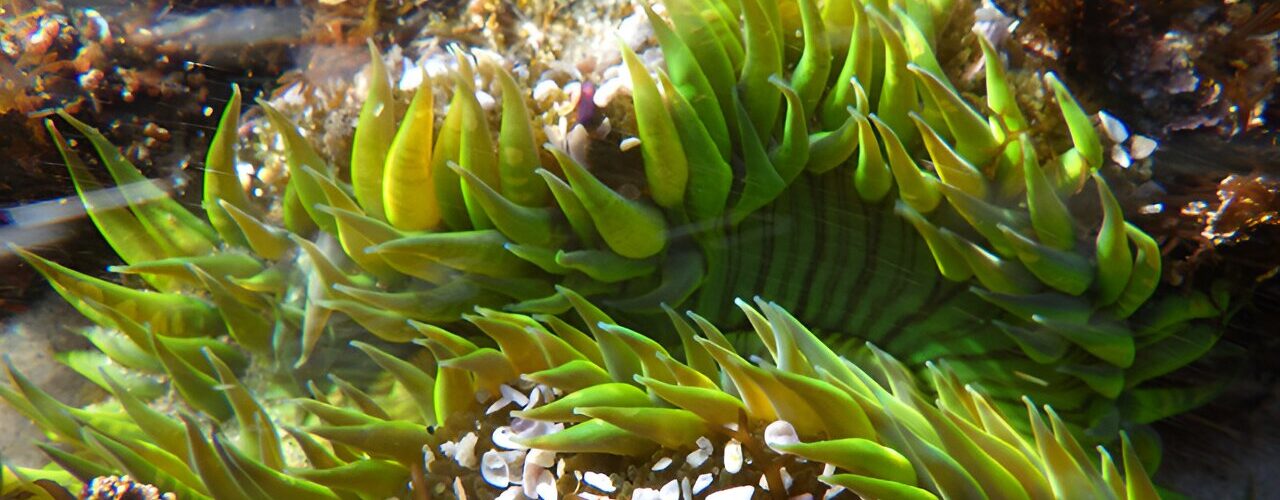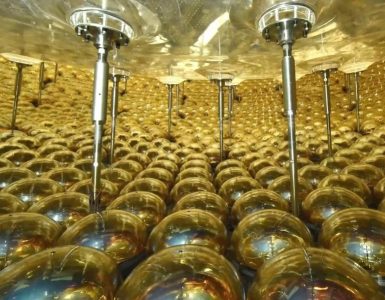For the first time, a team of researchers at Stanford University and UC San Diego’s Scripps Institution of Oceanography has uncovered a direct genetic link between fluorescence and color in sea anemones—those soft and tentacled tide pool creatures often encountered by beachgoers.
In a comprehensive paper, the team illuminates the mysterious role of fluorescent proteins and color variation within a group of sea anemones living in the intertidal zones of the Pacific coast of North America. These sea anemones—belonging to the genus Anthopleura and commonly referred to as sunburst sea anemones—exhibit a genetic color variation that ranges from vibrant neon-green to more subdued olive or gray-green hues.
The researchers found that the anemones’ color variation, or polymorphism, is controlled by different versions of a single fluorescent protein gene. The study also revealed that the fluorescent proteins are not just there for show; they function as potent antioxidants, safeguarding cells from oxidative damage, which is the most common kind of stress for cells.
Common stressors for sea anemones and other organisms in the tidal zone include continuous exposure to sunlight, desiccation, and the presence of oxygen radicals generated through photosynthesis.
The findings were published in the Proceedings of the National Academies of Sciences.
“The question that we were essentially trying to answer with this study was, ‘What makes these neon sea anemones so strikingly neon?’ This led us into an investigation of the intriguing world of fluorescent proteins, which have remained a mystery until now,” said lead author Nat Clarke, now a postdoctoral researcher at MIT who conducted the research while a Ph.D. student at Stanford University.
“This study sheds light on the multifunctional roles of fluorescent proteins in nature, balancing their spectral properties with vital physiological roles.”
The team turned to the community platform iNaturalist, which empowers citizen scientists to document biodiversity in their quest to find locations of the sometimes rare neon-green sea anemones.
From thousands of geotagged observations of Anthopleura sea anemones, it was found that the highest prevalence of the neon coloration was in Northern California, with up to 10% of the population found in this hue, while their abundance dwindled to less than 1% around San Diego.
It all started with a striking observation
The inspiration for the research project started in 2008 when retired UC Santa Cruz professor John Pearse was exploring the tide pools of Monterey Bay and made a profound observation: among the throngs of sea anemones in muted tones, only one had a vibrant, neon-green coloration.
After this initial encounter, he returned to check on the fluorescent creature numerous times throughout many years, finding that it retained its striking coloration no matter the time of year and despite variations in light levels and tidal conditions, suggesting this odd color was not the result of environmental or external factors.
An expert in the biology of sea anemones and other marine invertebrates, Pearse was curious to know more about the neon green anemone—why was it more fluorescent than others of the same species (and was it the same species?), living at the same location, on the same rock?
He enlisted the assistance of his wife Vicki Pearse—a leading expert on anemones based at Stanford University’s Hopkins Marine Station, and other colleagues to investigate the question. John Pearse also served as a co-author on the study, though he passed away before its publication.
The fieldwork portion of the study began in 2016, with Clarke and Pearse collecting tentacle samples from both neon and non-neon-colored anemones in the intertidal zone near the Hopkins Marine Station in Pacific Grove, California. Clarke then used a suite of molecular tools to isolate and sequence the fluorescent protein.
Examining biofluorescence in the lab
The biofluorescence portion of the research was carried out by Scripps Oceanography marine biologist Dimitri Deheyn and members of the Deheyn Lab, which specializes in examining light production and light manipulation in organisms. The researchers conducted spectral analysis of the newly identified protein using a spectrophotometer, a tool that examines light properties across various spectra.
In many species, color variations are considered phenotypic or observable traits, stemming from factors including diverse diets or adaptations to different environments. For example, species exposed to higher levels of light often exhibit darker pigmentation. The researchers were surprised to find that the variation of color within these sea anemones was not considered a phenotypic trait but rather a genotypic one related to one particular fluorescent protein gene.
“This is the first instance where we’ve observed a fluorescent protein dictating the color of a sea anemone or any marine invertebrate species,” said Deheyn, who served as senior author of the paper. “The fact that coloration is strictly tied to one very specific gene makes it even more intriguing and challenges assumptions held by most field observers.”
Protective role of fluorescent proteins
The researchers demonstrated that the anemones’ fluorescent proteins are strong antioxidants that can protect live cells against oxidative stress. In humans, oxidative stress can trigger migraines, but consuming antioxidants like blueberries and dark chocolate can help manage and prevent this stress.
Read More at Phys.org





